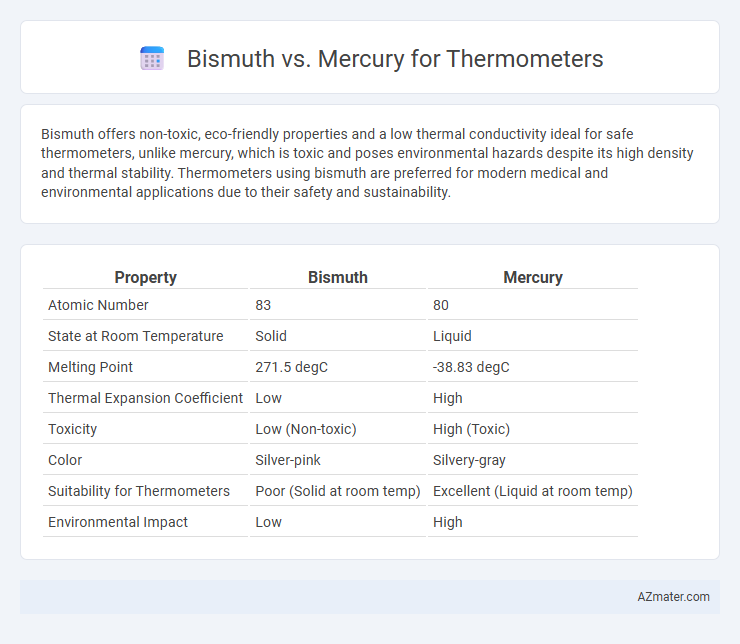Bismuth offers non-toxic, eco-friendly properties and a low thermal conductivity ideal for safe thermometers, unlike mercury, which is toxic and poses environmental hazards despite its high density and thermal stability. Thermometers using bismuth are preferred for modern medical and environmental applications due to their safety and sustainability.
Table of Comparison
| Property | Bismuth | Mercury |
|---|---|---|
| Atomic Number | 83 | 80 |
| State at Room Temperature | Solid | Liquid |
| Melting Point | 271.5 degC | -38.83 degC |
| Thermal Expansion Coefficient | Low | High |
| Toxicity | Low (Non-toxic) | High (Toxic) |
| Color | Silver-pink | Silvery-gray |
| Suitability for Thermometers | Poor (Solid at room temp) | Excellent (Liquid at room temp) |
| Environmental Impact | Low | High |
Introduction to Thermometer Materials
Bismuth and mercury are key materials historically used in thermometers due to their distinct physical properties. Mercury offers a high density and a wide liquid temperature range from -39degC to 357degC, making it reliable for precise temperature measurement in scientific instruments. Bismuth, though less common, is valued for being non-toxic and expanding predictably with temperature changes, providing an environmentally safer alternative in thermometer applications.
Overview of Bismuth and Mercury
Bismuth is a non-toxic, brittle metal with a low melting point of 271.5degC, making it a safer alternative for thermometers compared to mercury, which is a dense, silvery liquid metal with a melting point of -38.83degC and known toxicity risks. Mercury's high thermal expansion and visibility have historically made it the standard for precise temperature measurement despite environmental and health hazards. In contrast, bismuth alloys, often combined with indium and tin, offer non-toxic, stable alternatives with distinct phase changes suitable for safer, eco-friendly thermometer applications.
Physical and Chemical Properties Comparison
Bismuth and mercury differ significantly in their physical and chemical properties relevant to thermometers; bismuth has a higher melting point of 271.5degC compared to mercury's -38.83degC, making mercury liquid at room temperature while bismuth remains solid. Chemically, mercury is a heavy metal with high density (13.53 g/cm3) and excellent thermal expansion characteristics, ideal for precise temperature measurement, whereas bismuth's lower density (9.78 g/cm3) and brittleness limit its use in fluid thermometers. Mercury's toxicity contrasts with bismuth's non-toxic nature, influencing modern thermometer design toward safer alternatives without sacrificing measurement accuracy.
Temperature Measurement Accuracy
Bismuth offers superior temperature measurement accuracy over mercury in thermometers due to its lower thermal expansion coefficient, resulting in more precise and stable readings. Unlike mercury, which can contract or expand unevenly at varying temperatures, bismuth's predictable behavior enhances calibration reliability and consistency. This makes bismuth thermometers particularly advantageous in scientific and medical applications where exact thermal data is critical.
Safety and Toxicity Concerns
Bismuth is significantly safer than mercury for use in thermometers due to its low toxicity and environmental friendliness, posing minimal health risks if broken or spilled. Mercury, a heavy metal, is highly toxic and can cause severe neurological and respiratory damage upon exposure, requiring careful handling and specialized cleanup procedures to prevent contamination. Thermometers containing bismuth alloys offer a non-toxic, safer alternative while providing accurate temperature measurements without the hazards associated with mercury exposure.
Environmental Impact and Disposal
Bismuth-based thermometers offer a significant environmental advantage over mercury thermometers due to bismuth's non-toxic and biodegradable properties, reducing hazardous waste concerns. Mercury thermometers pose serious environmental risks as mercury is a potent neurotoxin that contaminates soil and water, requiring specialized disposal methods to prevent ecological damage. Proper disposal of mercury-containing devices involves hazardous waste protocols, while bismuth thermometers can be safely discarded with regular metal recycling streams, minimizing environmental impact.
Cost and Availability of Materials
Bismuth is more cost-effective and readily available compared to mercury, whose extraction and purification require more complex processes. Mercury's toxicity has also led to stricter regulations, limiting its availability and increasing costs. Bismuth-based thermometers offer a safer and more sustainable alternative, benefiting from lower raw material expenses and wider accessibility.
Applications in Different Industries
Bismuth is favored in thermometers used in medical and environmental monitoring due to its non-toxicity and stable thermal expansion, making it safer for laboratories and healthcare settings. Mercury retains advantages in industrial applications requiring precise temperature readings at high ranges, such as in mechanical and chemical processes, because of its high density and consistent thermal conductivity. Both metals serve niche roles, with bismuth increasingly replacing mercury to meet regulatory standards and health safety concerns in consumer products.
Advances in Thermometer Technology
Bismuth-based alloys have emerged as a safer alternative to mercury in thermometer technology due to their non-toxic and environmentally friendly properties, leading to increased adoption in clinical and industrial thermometers. Advances in bismuth thermometers exploit its unique thermal expansion characteristics, enabling precise temperature measurements while mitigating mercury's health risks and disposal challenges. Innovative designs incorporating bismuth enhance durability and sensitivity, marking significant progress in non-mercury thermometer development for safer, eco-conscious applications.
Future Trends and Recommendations
Bismuth is gaining traction as a safer, non-toxic alternative to mercury in thermometers due to its low toxicity and environmental friendliness, aligning with global health regulations and eco-friendly trends. Innovative developments in bismuth alloys enhance thermal sensitivity and stability, positioning bismuth-based thermometers as a promising future standard in medical and industrial applications. Manufacturers are recommended to invest in research on bismuth composites to improve accuracy and durability while adhering to sustainability-driven policies.

Infographic: Bismuth vs Mercury for Thermometer
 azmater.com
azmater.com